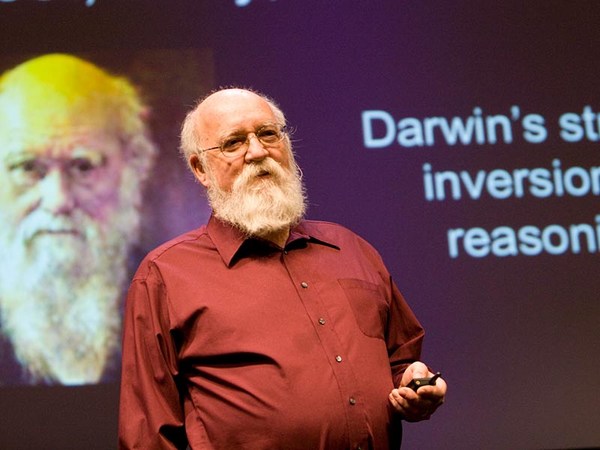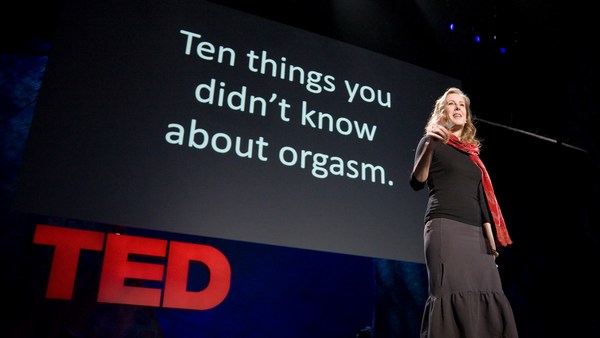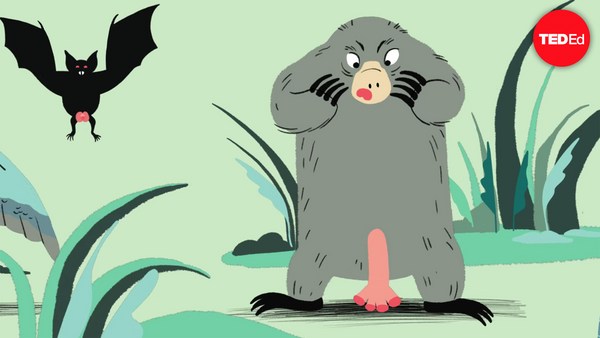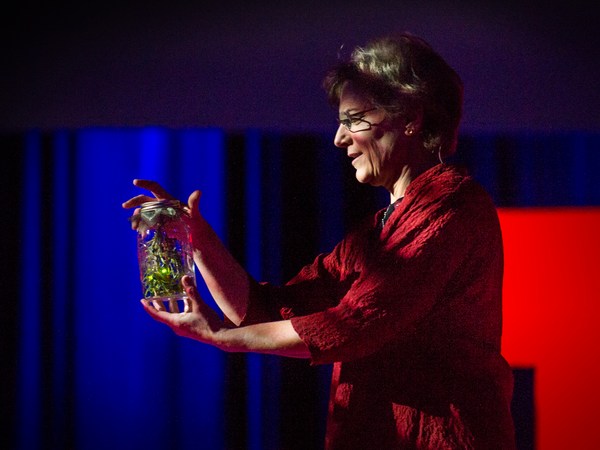Anyone in the room thought about sex today? (Laughter) Yeah, you did. Thank you for putting your hand up over there. Well, I'm here to provide you with some biological validation for your sordid daydreams. I'm here to tell you a few things that you might not have known about wild sex.
Now, when humans think about sex, male and female forms are generally what come to mind, but for many millions of years, such specific categories didn't even exist. Sex was a mere fusion of bodies or a trickle of DNA shared between two or more beings. It wasn't until about 500 million years ago that we start to see structures akin to a penis or a thing that gives DNA out, and a vagina, something that receives it. Now invariably, you're probably thinking about what belongs to our own species, these very familiar structures, but the diversity that we see in sexual structures in the animal kingdom that has evolved in response to the multitude of factors surrounding reproduction is pretty mind-blowing.
Penile diversity is especially profuse. So this is a paper nautilus. It's a close relative of squid and octopus, and males have a hectocotylus. Just what is a hectocotylus? A detachable, swimming penis. It leaves the [body of the male], finds the female through pheromonal cues in the water, attaches itself to her body and deposits the sperm. For many decades, biologists actually felt that the hectocotylus was a separate organism altogether. Now, the tapir is a mammal from South America. And the tapir has a prehensile penis. It actually has a level of dexterity in its penis much akin to what we have with our hands. And it uses this dexterity to bypass the vagina altogether and deposit sperm directly into the female's uterus, not to mention it's a pretty good size. The biggest penis in the animal kingdom, however, is not that of the tapir. The biggest penis-to-body-size ratio in the animal kingdom actually belongs to the meager beach barnacle, and this video is actually showing you what the human penis would look like if it were the same size as that of a barnacle. (Laughter) Mm-hm. (Laughter)
So with all of this diversity in structure, one might think, then, that penises are fitting neatly into vaginas all over the place for the purposes of successful reproduction. Simply insert part A into slot B, and we should all be good to go. But of course, that doesn't exactly happen, and that's because we can't just take form into account. We have to think about function as well, and when it comes to sex, function relates to the contributions made by the gametes, or the sperm and the eggs. And these contributions are far from equal. Eggs are very expensive to make, so it makes sense for females to be very choosy about who she shares them with. Sperm, on the other hand, is abundant and cheap, so it makes more sense for males to have a more-sex-is-better strategy when it comes to siring members of future generations.
So how do animals cope with these very incongruent needs between the sexes? I mean, if a female doesn't choose a particular male, or if she has the ability to store sperm and she simply has enough, then it makes more sense for her to spend her time doing other biologically relevant things: avoiding predators, taking care of offspring, gathering and ingesting food. This is, of course, bad news for any male who has yet to make a deposit in her sperm bank, and this sets the scene for some pretty drastic strategies for successful fertilization. This is bedbug sex, and it's aptly termed traumatic insemination. Males have a spiked, barbed penis that they literally stab into the female, and they don't stab it anywhere near her vagina. They stab it anywhere in her body, and the sperm simply migrates through her hemolymph to her ovaries. If a female gets too many stab wounds, or if a stab wound happens to become infected, she can actually die from it.
Now if you've ever been out for a nice, peaceful walk by the lake and happened to see some ducks having sex, you've undoubtedly been alarmed, because it looks like gang rape. And quite frankly, that's exactly what it is. A group of males will grab a female, hold her down, and ballistically ejaculate their spiral-shaped penis into her corkscrew-shaped vagina over and over and over again. From flaccid to ejaculation in less than a second. Now the female actually gets the last laugh, though, because she can actually manipulate her posture so as to allow the sperm of certain suitors better access to her ovaries.
Now, I like to share stories like this with my audiences because, yeah, we humans, we tend to think sex, sex is fun, sex is good, there's romance, and there's orgasm. But orgasm didn't actually evolve until about 65 million years ago with the advent of mammals. But some animals had it going on quite a bit before that. There are some more primitive ways of pleasing one's partner.
Earwig males have either really large penile appendages or really small ones. It's a very simple genetically inherited trait and the males are not otherwise any different. Those that have long penile appendages are not bigger or stronger or otherwise any different at all. So going back to our biological minds, then, we might think that females should choose to have sex with the guys that have the shorter appendages, because she can use her time for other things: avoiding predators, taking care of young, finding and ingesting food. But biologists have repeatedly observed that females choose to have sex with the males that have the long appendages. Why do they do this? Well, according to the biological literature, "During copulation, the genitalia of certain males may elicit more favorable female responses through superior mechanical or stimulatory interaction with the female reproductive tract." Mm-hm.
These are Mexican guppies, and what you see on their upper maxilla is an outgrowth of epidermal filaments, and these filaments basically form a fish mustache, if you will. Now males have been observed to prod the female's genital opening prior to copulating with her, and in what I have lovingly termed the Magnum, P.I. hypothesis, females are overwhelmingly more likely to be found with males that have these fish mustaches. A little guppy porn for you right there.
So we've seen very different strategies that males are using when it comes to winning a female partner. We've seen a coercion strategy in which sexual structures are used in a forceful way to basically make a female have sex. We've also seen a titillation strategy where males are actually pleasing their female partners into choosing them as a sex partner. Now unfortunately, in the animal kingdom, it's the coercion strategy that we see time and time again. It's very common in many phyla, from invertebrates to avian species, mammals, and, of course, even in primates.
Now interestingly, there are a few mammalian species in which females have evolved specialized genitalia that doesn't allow for sexual coercion to take place. Female elephants and female hyenas have a penile clitoris, or an enlarged clitoral tissue that hangs externally, much like a penis, and in fact it's very difficult to sex these animals by merely looking at their external morphology. So before a male can insert his penis into a female's vagina, she has to take this penile clitoris and basically inside-out it in her own body. I mean, imagine putting a penis into another penis. It's simply not going to happen unless the female is on board with the action. Now, even more interesting is the fact that elephant and hyena societies are entirely matriarchal: they're run by females, groups of females, sisters, aunts and offspring, and when young males attain sexual maturity, they're turfed out of the group. In hyena societies, adult males are actually the lowest on the social scale. They can take part in a kill only after everybody else, including the offspring. So it seems that when you take the penis power away from a male, you take away all the social power he has.
So what are my take-home messages from my talk today? Well, sex is just so much more than insert part A into slot B and hope that the offspring run around everywhere. The sexual strategies and reproductive structures that we see in the animal kingdom basically dictate how males and females will react to each other, which then dictates how populations and societies form and evolve.
So it may not be surprising to any of you that animals, including ourselves, spend a good amount of time thinking about sex, but what might surprise you is the extent to which so many other aspects of their lives and our lives are influenced by it.
So thank you, and happy daydreaming.
(Applause)





